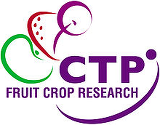RefERENCE: CTP_FCR_2021_3
Supervisors: Prof Xiangming Xu (NIAB EMR), Dr Tom Passey (NIAB EMR), Dr Zoltan Kevei (Cranfield University)
This student will be registered with Cranfield University. Beginning in October 2021, the successful candidate should have (or expect to have) an Honours Degree (or equivalent) with a minimum of 2.1 in Plant Science, Plant Pathology, Microbiology, or other related science subjects.
Background
Apple scab, caused by Venturia inaequalis, is one of the most important diseases on apple worldwide. The annual cycle of sexual reproduction of V. inaequalis is assumed to take place on fallen leaves in the winter, producing ascospores as primary inoculum for the next spring. Furthermore, random mating among scab strains of opposite mating types is assumed. However, we recently showed that this random mating assumption is not supported by the data collected in a mixed orchard over the last ten years. Our recent research data are consistent with an absence of (or very infrequent) recombination between isolates on different host cultivars.
Our data suggested that sexual mating is more likely to take place and succeed between isolates from lesions on the same leaf than contact between independently infected leaves in leaf litter on the orchard floor. Furthermore, our results also suggest that sexual reproduction is likely to be initiated before leaf-fall. If these are true, we need to re-visit current consensus/assumptions of scab population genetics, particularly regarding the recombination of existing fungal virulence factors, practicality of using mixed orchards, and management measures to reduce sexual reproduction before leaf-fall.
Objectives and approaches
This proposal will obtain direct evidence to test the following hypotheses: (1) Sex is initiated on the leaf before leaf-fall; and (2) Sex is far more likely to succeed between lesions on the same leaves.
Once we have tested the two hypotheses, we will study microbial-based methods to disrupt sexual reproduction on leaves. Then, we will identify the locus for V. inaequalis from existing and new genomic sequence data, and develop molecular markers for the two mating types. Availability of such a maker will greatly assist population genetic studies. Finally, we may conduct theoretical modelling on the scab population genetic structure taking into account the new knowledge of fungal sexual reproduction. The modelling will focus on the spread of virulence and fungicide resistance genes in the population.
The research results will have a huge impact on predicting the durability of resistance genes (hence feasibility of using mixed orchards), spread of fungicide resistance, and reducing primary inoculum for the following season.
Training
The successful candidate will gain a wide range of experience in plant pathology, fungal population genetics, modelling dynamics of fungal genetics structure conservation, and orchard disease management.
Application
Anyone interested should fill the online application form before the deadline of 8th February 2021. If need further help or clarification, please contact recruitmentctp@emr.ac.uk.
Contact Prof Xiangming Xu for an informal discussion on research contents.
